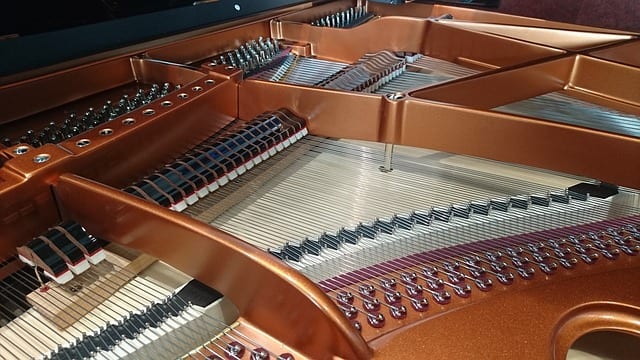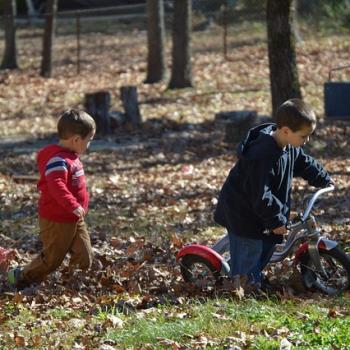
We were reaching the end of a long page of multiplication problems.
Rosie is officially in the second grade, but we’ve skipped to the third grade book because she has a good head for math. She’s understanding multiplication pretty well, for the most part. Her Achilles heel is that she is an incurable goofball. When she gets bored, she starts to make jokes.
The jokes started two-thirds of the way down the page that night, with Rosie deadpanning that she no longer knew what multiplication was. “Two times three is twody-three. Two times three is five. Well, what is it? What’s ‘times’ again? Is it add or subtract?”
Then we got to the word problems at the bottom of the page. I have to read those aloud because she’s not quite up to that reading level yet. “Sally practices her piano for one hour every day of the week. How many minutes does Sally practice per day?”
“What’s a piano?” asked Rose.
“Pee-a-no,” I enunciated carefully. “I said pi-AH-no just to show off. How many minutes?”
“But what’s a piano?” Rose insisted, her eyes twinkling.
“You know what a piano is and it doesn’t matter. It’s just a math problem. How many minutes are in an hour?”
“But,” Rose pressed, “What IS a piano?”
“It doesn’t matter what a piano is. I could pronounce it ‘PIE-anna’ and it wouldn’t make a difference. It’s just a word. It wouldn’t matter if I said ‘Sally practices her hasenpfeffer for one hour every day,’ the answer would be the same. Math doesn’t care about musical instruments. Math is cold and dispassionate.” I imagined any number of passionate mathematicians shaking their protractors at me for that statement, but I was frantic to get the lesson over with one way or another. “Math doesn’t care about your feelings, JUST TELL ME HOW MANY MINUTES SHE PRACTICED.”
Rose was adamant. “But what is a PIE-anna?”
“It’s a big black… you know, I’ve never been quite sure if it’s a stringed instrument or a percussion instrument. You do hit the keys but it has so many strings.”
“No it doesn’t,” Rosie replied.
“Of course it has strings,” I insisted. “Lots.”
“It doesn’t have any strings at all,” said Rose.
“All right, young lady,” I said, googling. “We’re going to settled this right now. If you’re going to be a smarty pants you can learn something.”
This was the second time I’d pulled that “if you’re going to be a smarty pants you can learn something” bit, and then showed her a video. Earlier that day I’d made her watch a scene from The Merchant of Venice because she wouldn’t stop randomly shouting “REVENGE!” in a chilling voice while doing her phonics.
We watched an enchanting two-part video, a CGI deconstruction of the different pieces of a piano and how they all fit together to make music happen. I knew it was to do with the hitting of strings with little hammers. But in all my years of being a very bad musician despite my beloved piano teacher’s patience, I still didn’t know the half of it. Arithmetic may not care about pianos, but pianos depend a great deal on math and engineering. An enormous amount of mechanical wood and metal, meticulously arranged, becomes a sleek black box that sings as if it’s a part of nature. And that’s just the physical instrument, of course: there is more math and physics than my teacher could ever have taught me in the notes on the paper and the specific touch that I never picked up, for banging the keys to make it sound like music instead of noise. I don’t know if math cares about my feelings, but it certainly is responsible for making my hair stand on end when I hear a really good piece of music.
Here, take a look:
I don’t know why that simple demonstration gave me chills.
Rose sat stock still for the entire video demonstration, when she’d been bouncing across the room like a pinball while she did her arithmetic. I asked her if she was done, but she said she wanted to learn more.
I brought up another short two-part demonstration, about the development of the modern piano from a Late Middle Ages instrument known as a clavichord. She listened as the piano expert played a tune on the jangly box and remarked about how quiet it was, meant for private concerts with no voices. Then he moved on to the harpsichord with its quick twangy stringy notes, and demonstrated that instead of hammers, the harpsichord had a series of little devices that plucked the strings like a harp. Then he showed an early piano with the “pedals” on the bottom of the keyboard; he had to lift his knees to make them work. Finally, he played a grand piano like the one we’d seen deconstructed in the first video.
Here’s that video, if anyone would like to see:
“Now,” I said, “do you believe me that pianos have strings?”
“Can I watch Mr. Rogers?” asked Rose.
Rose hadn’t asked to watch Mr. Rogers in over a year. She finally got to the age where she regards him as too babyish. But hearing the piano certainly brought back memories of the omnipresent jazz combo improvising off camera on his “television visits.”
“No,” I said. “Not until you solve that word problem. Sally practices her piano for–”
“Sixty,” said Rose. “Can I watch Mr. Rogers now?”
I let her watch Mr. Rogers, the episode where people make chalk and then the one where people make puffed oat cereal. That jazz piano music in the background really is excellent.
Afterwards I asked around my friends, who said that the piano is technically a percussion instrument because the strings are hit rather than plucked– but then, I also have a piano teacher friend who says that you can play certain piano pieces by opening it up and plucking strings.
Some of our school days go like this, and some are more disorganized.
This wasn’t the reason we started homeschooling in the first place, but it is a major reason why I like it.
You see, it turns out I didn’t really know what a piano was either.
(image via Pixabay)
Steel Magnificat runs almost entirely on tips. To tip the author, visit our donate page.












